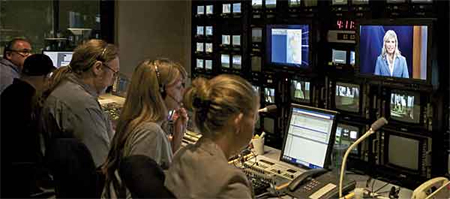Tag: Television programs
Output: Producers swarm a conference, an ‘extreme journalist’ trots the globe, and more
A conference about ideas and creativity provided the latest opportunity for a group of adventurous radio producers to challenge their own inventiveness ...Q&A: ‘Building on strengths’ key to PBS strategy
After stints in the cable world as producers and programmers, PBS execs Beth Hoppe and Donald Thoms returned to PBS last August ...Shows sate ‘appetite for a real-world experience’
Know something about antiques? Prove it,” screamed the ad seeking “pickers” for Market Warriors, the long-awaited companion series to PBS’s most popular primetime program, Antiques Roadshow. ...PubTV multicaster V-me faulted for airing ‘ordinary commercials’
V-me, the Spanish-language multicast channel carried by 42 public TV stations, pulled underwriting spots from its schedule last month amid complaints about ...Multiplatform: KPBS extends its news expansion to television
With the launch of KPBS-TV's Evening Edition, the pubcasting outlet took another big step towards General Manager Tom Karlo’s ambitious goal to become “the ...NEA slashes funds to WNET arts series, elevates digital media
The Arts on Radio and Television fund of the National Endowment for the Arts, a source of millions of programming dollars for ...WTCI plans to launch a new multicast channel of local programming with seed funding from ...
WTCI plans to launch a new multicast channel of local programming with seed funding from the city of Chattanooga. The Voyager channel will ...Late date seals fate of Oregon Public Broadcasting’s debate
When three unlikely partners — a conservative newspaper in the nation’s capital, a blue-state Republican organization and a public broadcasting station in ...PBS weighs new night for Indie Lens, POV, after uproar
PBS has agreed to consider “alternative scheduling options” for the independent production showcases Independent Lens and POV, which lost carriage and audience after the network moved ...Suspects charged in connection with 2011 cyberattacks on PBS, other entities
Five suspects, considered among the “most sophisticated hackers in the world” by authorities, were arrested and charged Tuesday (March 6) in Manhattan ...Output: PBS’s first-ever Online Film Festival screens 20 short films, gilded applause for The Moth, public ...
Partners in the project are the pubmedia minority consortia — the Center for Asian American Media, Latino Public Broadcasting, Native American Public ...Downton gives public TV a ratings blockbuster
The Season 2 finale of Downton Abbey on Masterpiece Classic, aired Feb. 19, won the biggest audience for a PBS program since the premiere of Ken ...CPB will seek operator to develop American Archive; director leaves project
Having lost its digital projects fund last year, CPB lacks the money to develop the American Archive much further, according to Mark ...Unusual rights delay: hint of budget strife?
PBS’s ongoing negotiations to curb per-hour costs of producing programs and to assert more control over content are increasing friction with its ...Next, PBS Tuesday schedule goes for the flow
If this is Tuesday, it must be history. At least, that’s what PBS hopes viewers think as the service moves forward with ...






